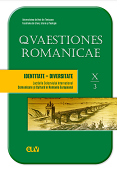Diversité ethnique et confessionnelle dans la basse vallée du Mureș au XIXe siècle
Ethnic and confessional diversity in the lower Mureș valley in the 19th century
Author(s): Maria Alexandra PanteaSubject(s): Theology and Religion, Cultural Anthropology / Ethnology, Demography and human biology, 19th Century, Ethnic Minorities Studies, Sociology of Religion
Published by: Universitatea de Vest din Timişoara
Keywords: Romanians; Hungarians; Slovaks; Serbs; Jews; Germans; the lower Mureș;
Summary/Abstract: The modernization process, which also gained momentum in the rural world in the first half of the 19th century, especially in the villages located in the plain area, is also the result of the ethnic and confessional diversity in the Lower Mureș area. At the beginning of the 19th century, a late colonization took place here and new ethnic and religious communities appeared in the area, such as Slovaks, Germans and Jews. Their training and development strongly marked the modernization process and transformed the area into an ethnic and confessional mosaic, but it also produced major changes in Romanian society, which the newcomers influenced. The 19th century is one of prosperity for the Hungarian communities, which were older and consolidated. This is the case of the community of Pecica, where there was also a real Hungarian elite, from among which personalities such as Ormos Zsigmond or Klebelsberg Kuno emerged. At the same time there was also a demographic decline of the Serbian ethnic element. During the 19th century, Jewish communities appeared in the villages of the area, which played an important role economically, although they were not important from a demographic point of view.
Journal: Quaestiones Romanicae
- Issue Year: X/2023
- Issue No: 3
- Page Range: 84-90
- Page Count: 7
- Language: French

